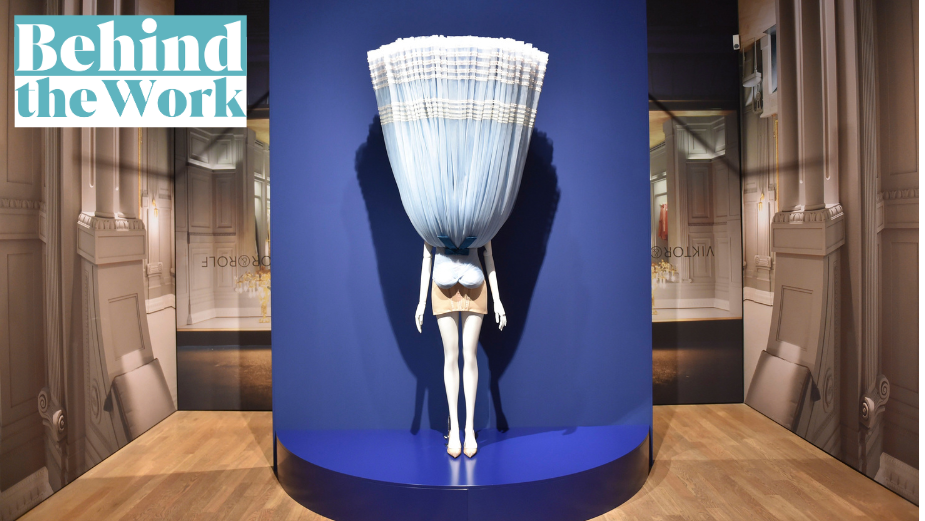Fashion
Fashion Statements: How a New Viktor&Rolf Exhibition Blended Immersion and Entertainment | LBBOnline

It’s not easy to encapsulate the work of Viktor Horsting and Rolf Snoeren. That’s largely because the Dutch fashion visionaries have built up a profoundly idiosyncratic reputation, ever since founding their avant-garde luxury fashion house in 1993.
But that was part of the task facing the team at Rodeo FX. As part of a new exhibition at the The Kunsthalle München in Germany, the Montreal-based creative studio needed to find a way to elevate the museum’s offerings by providing an experience that felt memorable, original, and true to the story of the Dutch fashion icons.
The result is Fashion Statements, which is running up until October 6th. The exhibition allows audiences to dive into the world of Viktor&Rolf, reflecting the duo’s passions, obsessions, and singular artistic vision through a multisensory lens. Uniquely suited for the task, Rodeo and its experiential department, lead by Nicolas Dubé-Pauzé, was able to tap into its array of in-house expertise to make this experiential project come to life. Most notably, the company was able to leverage their Unreal capabilities to create and conceptualise the exhibit, as well as Rodeo FX Audio’s 20+ years of work in spatial audio design.
To find out more about the exhibition – and how they found the balance between crafting a resonating, unique experience whilst staying true to the source material – LBB caught up with Rodeo’s Romain Demongeot, alongside Unreal creative artists Yoma Charret and Anthony Lassus.
Rejecting Conformity
Fittingly for a celebration of artistic genius, Fashion Statements has been a long time in the making. The genesis of the idea stretches back to a meeting in Montréal between the Rodeo team and Thierry-Maxime Loriot, the curator of exhibitions at The Kunsthalle München. That initial conversation sparked the tentative ideas which would go on to form the experience, but it was only a faint outline at the time. “That’s one of the first things you need to understand about working with museums as opposed to more traditional advertising”, explains Romain. “The timelines stretch out a lot longer!”.
But in this instance, that suited the team just fine. As Romain goes on to explain, the project’s slow start allowed “space for ideas to breathe and evolve”, without which Fashion Statements might have looked a lot more like a traditional museum exhibition. However, just like its source material, the exhibition eventually became something shaped entirely by forces outside of convention and expectation – becoming entirely one-of-a-kind.
“We wanted to do something unique, bold, and creative”, recalls Anthony. “But at the same time, it was important to us that the exhibition was truly adding something to the audience’s overall experience. That there was something substantial behind it all”.
As a result, the team’s focus turned more towards the exhibition’s practicalities over time. “After careful consultations with Thierry-Maxime, we had a better understanding of what was going to be possible within the museum’s space”, says Romain. “After that point, it was purely a process of refinement. We went through a lot of AR and XR ideas, but ultimately decided that we wanted to be close to the physical world. That’s why the finished exhibition leans into optical illusions in a way that really surrounds and envelops the audience”.
That immersive quality is something that was prioritised by the team throughout the creative process. The exhibition itself is dreamlike, allowing audiences to dive into a distinctive visual world with a multi-sensory approach. It’s an effect which speaks to the ideas discussed at that initial conversation with Thierry-Maxime at the outset of the project. “It’s very rewarding to see everything come alive, from the original schematics to the reality of the exhibition”, says Yoma.”It’s always something else when you see something you put on paper take shape in reality”.
Embracing Immersion
Throughout the entire process, the team were constantly anchored by a respect for the source material. Viktor&Rolf’s legendary, singular style was something that the exhibition would need to highlight. “They’re proudly iconoclastic”, says Romain. “It reminds me of how brands in the same categories can often have similar logos. Fashion is no exception, which can make the brand landscape feel quite confirming. But that’s not Viktor&Rolf. They don’t Ïcare about trends, only their own vision – and the result is a style that feels totally unique”.
As Anthony sums up, “they react to pop culture, but not in a way that embraces it. If anything, they do the opposite”.
Thierry-Maxime himself points out that Rodeo’s success in communicating these qualities through the exhibition was no small feat. “Rodeo’s great strength lies in its ability to complement an existing subject, in this case, the work of great fashion designers”, he says. “They excel in enhancing and elevating the work of major creators, always collaborating and considering the project’s initial intention to stay entirely true to the artists’ work”.
And, perhaps most excitingly of all, Viktor&Rolf themselves feel similarly. “”It felt like a postmodern experience for us, revisiting our own work through the eyes of a third party”, they told Vogue magazine in March. “We were very impressed that [the curator] turned to a Canadian company, Rodeo FX, which brought its share of visual effects to the exhibition, including a hologram, shadows, and brought clothes to life… It allowed the elevation of our pieces in a new way.”
In so many ways, the Fashion Statements exhibition ultimately exists as something outside of what audiences might expect walking into a museum exhibition. As Romain explains, this is fundamentally by design. “We didn’t look to any other exhibitions for inspiration. This was because we didn’t want to feel like something that was iterating on old ideas”, he says. “We wanted to avoid conformity and be something that felt entirely new. After all, what better way to pay tribute to Viktor&Rolf themselves?”
But as well as being avant-garde, the event would still need to keep audiences engaged throughout. “Something which Thierry-Maxime repeatedly reminded us – which we all absolutely agreed with – was that people stream blockbuster content on their phones, and they order from Amazon with instant gratification”, says Yoma. “So we wanted to create an experience that stood out from a digitally-driven world, leveraging the visitors’ physical presence and making it a staple of the exhibition”.
That vision was shared by all stakeholders across the project, and that alignment allowed the team a certain degree of freedom to be creative. “The only true problems we encountered were technical as opposed to creative”, notes Yoma. “For example, when working with projections and optical illusions, scale becomes incredibly important. It was often the case that something which looked fine – or barely noticeable – on our screens would suddenly look out of place or strange when blown up onto a wall or ceiling. That meant there was a lot of back and forth, making adjustments to ensure we got everything just right. But it was never a problem which felt insurmountable”.
Ultimately, there was a shared feeling of satisfaction which was palpable across the Rodeo team when reflecting on the exhibition. “In a creative sense, this whole exhibition was a joy”, says Romain. “We were making art in celebration of artists – that felt very freeing”.
And for attendees, the opportunity to be immersed in the world of Viktor&Rolf is too good to pass up. As Thierry-Maxime continues to say, “Whether it’s Russian Doll, using a holo ghost to transport visitors into a dramatic Dutch fashion performance; the Zen Garden, whisking us away to Kyoto with its cold, futuristic vibe, featuring clothes that seamlessly blend with the garden’s intricate designs; or the mesmerising video of the Vampires, paying homage to German expressionist films, each piece not only tells its own story but also cleverly nods to the inspirations of both the creators and the curator”.
With over 100 objects present throughout, there’s no better way to gain an insight into the minds and visions of two of fashion’s most infamous and influential minds.

:quality(70):focal(958x822:968x832)/cloudfront-us-east-1.images.arcpublishing.com/shawmedia/JAEFIIKPTVFAPKJ55WWVVO7HAY.jpg)





